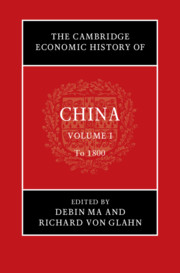Book contents
- The Cambridge Economic History of China
- The Cambridge Economic History of China
- The Cambridge Economic History of China
- Copyright page
- Contents
- Figures
- Maps
- Tables
- Contributors to Volume I
- Acknowledgments
- Note on Citations
- Introduction to Volume I
- Part I Before 1000
- Interlude
- Part II 1000 to 1800
- 7 Ecological Change and Resource Constraints
- 8 Population Change
- 9 Public Finance
- 10 Political Economy
- 11 Law and the Market Economy
- 12 Property Rights and Factor Markets
- 13 The Rural Economy
- 14 Cities and the Urban Economy
- 15 The Monetary System
- 16 Merchants and Commercial Networks
- 17 Foreign Trade
- 18 Production, Consumption, and Living Standards
- Bibliography of Primary Works Cited
- Index
- References
15 - The Monetary System
from Part II - 1000 to 1800
Published online by Cambridge University Press: 07 February 2022
- The Cambridge Economic History of China
- The Cambridge Economic History of China
- The Cambridge Economic History of China
- Copyright page
- Contents
- Figures
- Maps
- Tables
- Contributors to Volume I
- Acknowledgments
- Note on Citations
- Introduction to Volume I
- Part I Before 1000
- Interlude
- Part II 1000 to 1800
- 7 Ecological Change and Resource Constraints
- 8 Population Change
- 9 Public Finance
- 10 Political Economy
- 11 Law and the Market Economy
- 12 Property Rights and Factor Markets
- 13 The Rural Economy
- 14 Cities and the Urban Economy
- 15 The Monetary System
- 16 Merchants and Commercial Networks
- 17 Foreign Trade
- 18 Production, Consumption, and Living Standards
- Bibliography of Primary Works Cited
- Index
- References
Summary
Money serves as a means of exchange in any society and in any period. However, depending on place and time, money exhibits distinct characteristics. Chinese imperial monetary history spotlights a blind side about money that mainstream thinking overlooked. Chinese historical experience is replete with examples of money use transcending the theoretical frameworks of those who attribute the acceptability of money to its intrinsic value as well as those who emphasize enforcement by public authorities. Chinese monetary history may appear highly irregular from the viewpoints of contemporary foreign observers and modern social science, but a coherent system surely existed in an endogenous way behind the apparent disorder.
Keywords
- Type
- Chapter
- Information
- The Cambridge Economic History of China , pp. 560 - 596Publisher: Cambridge University PressPrint publication year: 2022



